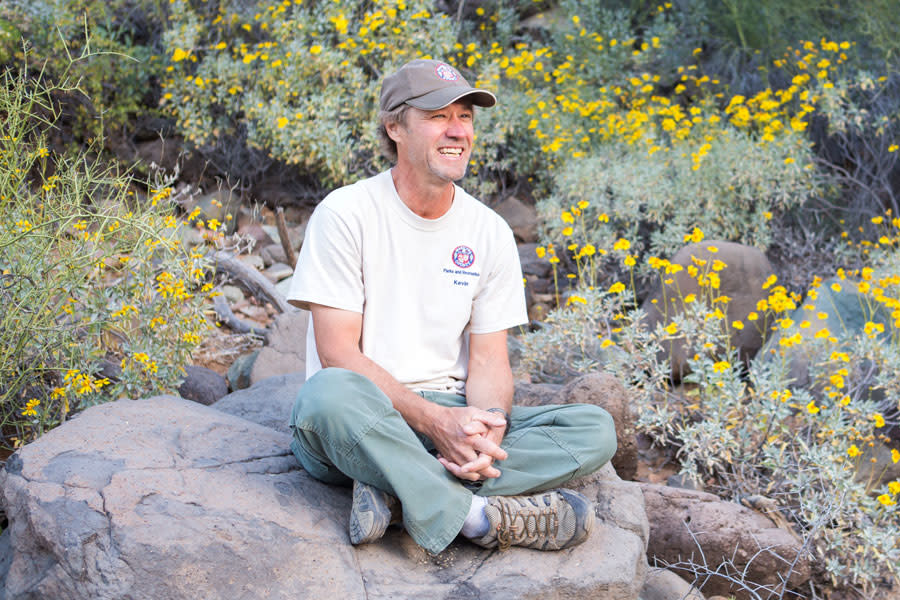400 species of desert grow in this tiny county park, and ranger Kevin Smith knows (almost) all of them.
I fell in love with flowers in Phoenix.
Before I moved here, I liked the plastic-wrapped, cut flowers I bought at the grocery store: Gerber daisies, tulips, stargazer lilies.
But after seeing brilliant gold Mexican poppies blanketing a mountainous hillside and flaming ocotillo buds reaching for the sky, I crushed on desert wildflowers. Now nothing else compares.
And come spring, all you have to do is step onto a trail to encounter fantastical blooms of every color, shape and size.
Ranger Kevin Smith’s tousled blonde hair and rugged good looks are straight out of central casting. He’s worked at Cave Creek’s Spur Cross Ranch Conservation Area, part of the Maricopa County Parks and Recreation network, for 10 years. He guides numerous wildflower hikes throughout the spring and summer.
Trying to predict how profuse the wildflowers will be or which trail is in bloom when is folly, says Smith. Variables such as temperature and rainfall are just two factors that affect the show.
“Because we had a lot of rain in the fall and winter, I was thinking it was going to be a banner year,” he says of the 2016 wildflower season. “But our January cold snap might not be so good for certain species. Still, I think it’ll be better than average.”
Though it is the smallest of the Maricopa County parks, Spur Cross has documented some 400 wildflower species, making its diversity unrivaled. As is typical in the Sonoran Desert, about half the species are annuals.
I’ve always thought brittlebush was the first of the flowering shrubs. But Smith corrects me; it’s actually comb bur, an annual with minuscule white flowers and fruit curved like the crescent moon. Rabbits and ground squirrels love it.
Because the Phoenix area warmed up fast this year, things are progressing quickly. Smith says another two or three soakings between late February and mid April would be fortuitous.
It’s early morning and we’re walking along the creek bottom on the Dragonfly Trail, a lush riparian area with sandy soil. Smith points out desert marigolds (their yellow heads blowing in the breeze), white desert tobacco, wispy red fairy dusters and the elegant blooms of sacred datura, which will close in the heat of the day, then reopen in the evening hours. I also spot cheery orange globe mallow.
As we enter Boca Grande Wash, the petite, trumpet-shaped scarlet blooms of the chuparosa are riotous with hummingbirds. (As it happens, chuparosa is Spanish for hummingbird.)
“It’s like Grand Central Station right now,” says Smith of the energetic hummers.
I ask which flowers attract the most pollinators, specifically butterflies.
“Butterflies love buckwheat, sweet bush and desert lavender, which grow in the washes,” Smith says.

During these hikes, Smith likes to point out how both animals and native people used plants for food and medicine. At Spur Cross, mule deer, fish, frog and lizard sightings are frequent.
In mid March, Smith sends people toward Elephant Mountain to see purple lupines and scorpion weed.
I love the neon, almost lurid, pinks, reds, yellows and oranges of cactus flowers. Many are easy to spot against the desert backdrop, but I like to peek under buckhorn cholla and brittlebush for the flash of tantalizing pink blossoms that encircle the tiny pincushion cactus. They bloom in response to rain.
I ask Smith if he has a favorite flower. He considers the question and takes a beat to answer it.
“They’re all my favorites in their own special way,” he says. “But datura is one of my favorites, along with strawberry hedgehogs and saguaro blooms.”
I nod in agreement. Picking a favorite is impossible.
“And May is fantastic because the ironwood and palo verde bloom,” he adds.
Smith posts wonderful photos to the Spur Cross Facebook page. I ask him if he has any tips for amateurs looking to capture a great image with a smartphone.
“Avoid midday; the light is too harsh and washed out,” he suggests. “Shoot with the sun behind you so the flowers are fully illuminated. And try crouching down, shooting from ground level or from the side with the open sky so the flowers really show up.”
As we wrap up our time on the trail, I ask for two more recommendations: a good guidebook and website to help me identify what I’m seeing. Because every season and every trail offers something new.
Smith doesn’t hesitate.
“The Falcon Guide to Sonoran Desert Wildflowers and Anne Epple’s Field Guide to the Plants of Arizona work really nice as companions, and they are arranged by flower color. And all the parks around the state feed into the Desert Botanical Garden website, so you can see what’s at peak where.”
Smith departs, but I linger. Because my love affair with desert flowers is enduring.
IF YOU GO
The Maricopa County Parks and Recreation Department offers guided wildflower walks and hikes at Spur Cross Ranch Conservation Area and many of its other regional parks. Visit maricopacountyparks.net to learn more.
Discover more places to spot beautiful blooms at our Where to See Wildflowers in Phoenix blog post.
You Might Also Like
Where to See Wildflowers in Phoenix
Put on your hiking shoes and get ready for a beautiful display of color from the desert this spring…
Best Scenic Views in Phoenix
From saguaro-studded hillsides to a glittering downtown skyline, see where you can snap your next…





